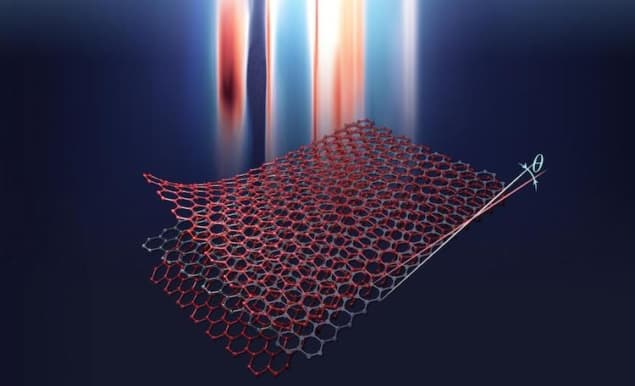
Two’s company, but three’s a crowd – unless you’re trying to make graphene superconduct at higher temperatures. That is the finding of researchers at Harvard University in the US, who discovered that the superconducting state in three stacked and twisted layers of graphene is more robust to temperature increase than the equivalent state in two-layer graphene. The researchers also found evidence that superconductivity in the trilayer system comes from strong interactions between electrons, rather than weak ones as in most conventional superconductors – corroborating a result reported a few days earlier by a separate team at the Massachusetts Institute of Technology (MIT).
A sheet of graphene consists of a simple repetition of carbon atoms arranged in a two-dimensional hexagonal lattice. When two sheets of graphene are placed atop each other and slightly misaligned, they form a moiré pattern, or “stretched” superlattice that dramatically changes the electronic interactions in the material compared to its pristine counterpart. The misalignment angle is critical: in 2018, the MIT group, led by Pablo Jarillo-Herrero, discovered a so-called “magic” angle of 1.1° where the material switches from an insulator to a superconductor. This means the twisted graphene can carry electrical current with no resistance below a superconducting transition temperature, Tc, of 1.7 K.
More robust superconductivity
In the Harvard study, a team led by Philip Kim made twisted trilayer graphene by stacking three sheets of graphene on top of each other at small twist angles of opposite signs. The twist angle between the top and middle layer is 1.5° while that between the middle and bottom layer is -1.5°.
Kim and colleagues studied the conductivity of these sheets by applying a voltage to them and then measuring the current that circulated through them. They measured a Tc for a twisted trilayer of around 2.3 K, or about 40% higher than similarly prepared twisted bilayer graphene.
The researchers report that the new structure is also extremely sensitive to the applied voltage. By varying the electric field, they found that the superconductivity in the material stems from strong interactions between electrons – a factor that could help explain the increase in Tc.
“While weakly interacting superconductors are fragile and lose superconductivity when heated to a few Kelvin, strong coupling superconductors are much more resilient but much less understood,” explains team member Eslam Khalaf. “Realizing strong coupling superconductivity in a simple and tuneable system such as trilayer graphene could pave the way to finally develop a theoretical understanding of strongly-coupled superconductors to help realize the goal of a high temperature, maybe even room temperature, superconductor.”

‘Magic-angle’ graphene doubles up
Close-to-room-temperature superconductors are, he adds, the “holy grail” of condensed- matter physics, with important real-world applications in areas such as electricity transmission, transport and even quantum computing. Unfortunately, today’s superconductors, including graphene, only work at ultracold temperatures or ultra-high pressures.
The Harvard researchers, who report their work in Science, say they will continue to investigate the origin of the peculiar superconductivity they have unearthed. “We also aim to find a way to obtain even more robust superconductivity in twisted 2D materials,” Kim tells Physics World.



